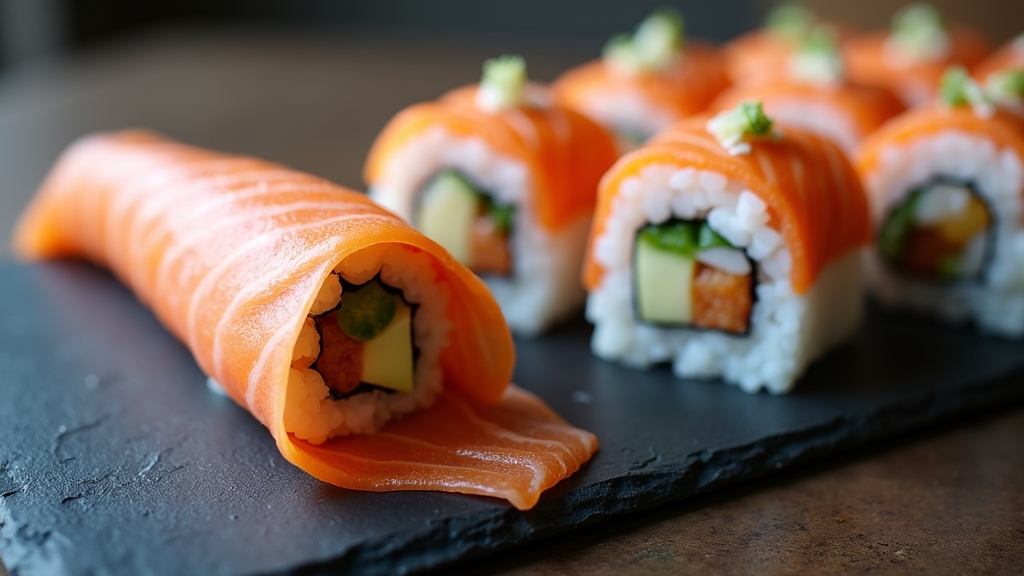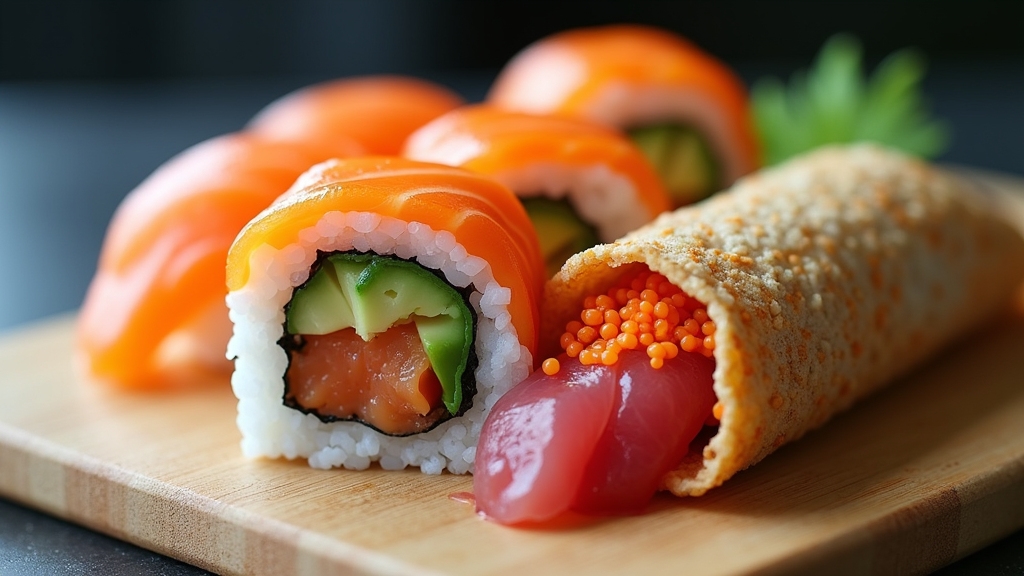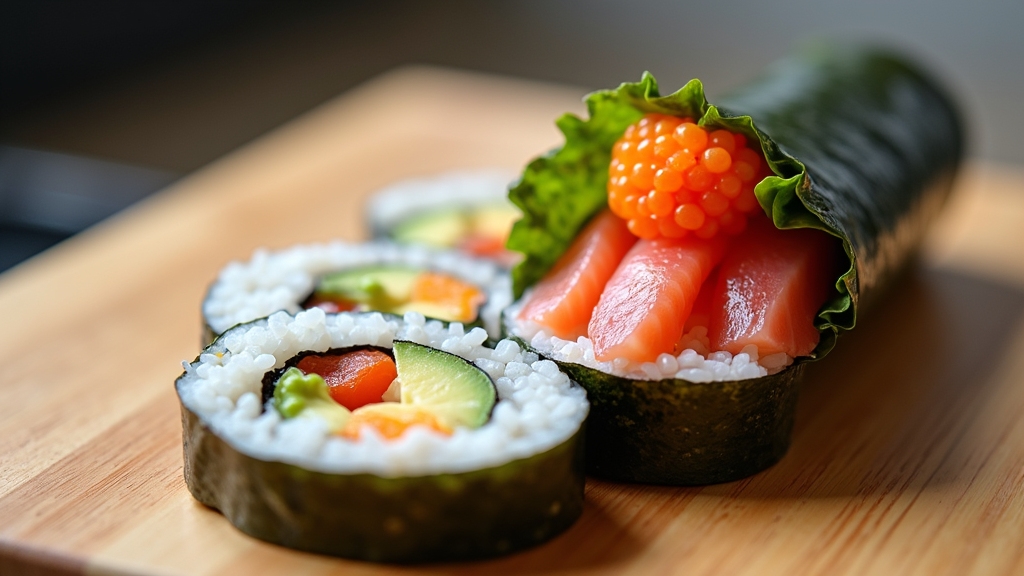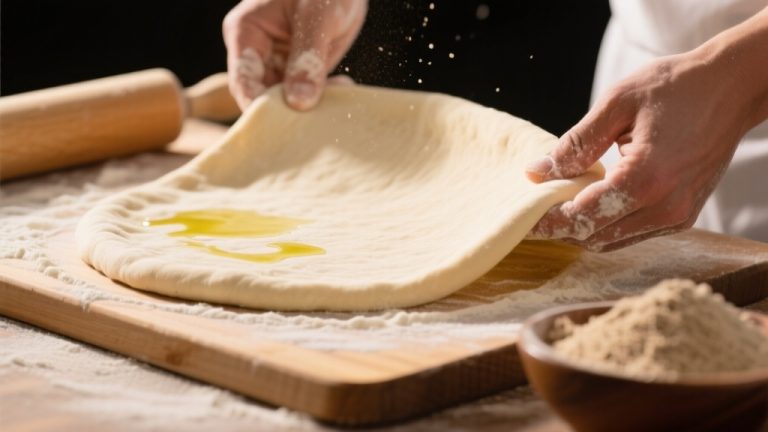Sushi Hand Roll vs Cut Roll: Key Differences Explained Simply
You’ll notice hand rolls are cone-shaped, filled generously with bold ingredients and eaten by hand for a casual, quick bite. Cut rolls, on the other hand, are cylindrical, sliced into uniform pieces perfect for sharing and elegant presentation.
Hand rolls use less rice and showcase fillings prominently, while cut rolls balance rice and fillings evenly with precise rolling techniques. If you want to explore how each suits different occasions and tastes, there’s plenty more to discover.
Key Takeaways
- Hand rolls (temaki) are cone-shaped, hand-held, and eaten whole, while cut rolls (makizushi) are cylindrical, sliced, and shared in bite-sized pieces.
- Hand rolls use less rice, emphasize bold fillings, and are quick, casual snacks; cut rolls have more rice and layered fillings for balanced, elegant bites.
- Cut rolls require a bamboo mat for tight rolling and precise slicing, whereas hand rolls are shaped by hand and sealed with water for easy eating.
- Hand rolls suit casual, on-the-go meals and personalized servings; cut rolls fit formal dining and social sharing with uniform presentation.
- Nutritionally, hand rolls often contain more calories per piece due to fillings and rice, while cut rolls offer controlled portions with balanced rice-to-filling ratios.
At a Glance: Sushi Hand Roll vs Cut Roll Comparison
| Feature | Hand Roll (Temaki) | Cut Roll (Maki) |
|---|---|---|
| Shape & Structure | Cone-shaped, wider at the top, tapering to a point | Cylindrical log sliced into bite-sized pieces |
| Size | Larger, about 3–5 inches, eaten whole | Smaller, 6–8 slices for sharing |
| Eating Style | Held by hand, eaten immediately | Picked up with chopsticks, easy to share |
| Rice-to-Filling Ratio | Less rice, fillings stand out more | Balanced mix of rice and fillings |
| Fillings Style | Bold, 1–3 standout ingredients like tuna or avocado | Layered combinations with seafood, veggies, sauces |
| Tools Used | Rolled by hand, no mat required | Requires bamboo mat (makisu) for tight rolls |
| Presentation | Served as individual cones | Served on platters in neat rows |
| Freshness | Best eaten right away; nori softens quickly | Holds freshness longer when refrigerated properly |
| Dining Experience | Casual, portable, single-serving | Refined, communal, suitable for formal dining |
Shape and Structure Differences

When you compare sushi hand rolls (temaki) to cut rolls (maki), the most obvious difference lies in their shape and structure. Hand rolls form a distinctive cone shape, wide and open at one end, tapering to a point, making them palm-sized and perfect for eating whole.
You roll them by hand without tools, which keeps the process quick and simple. Typically, hand rolls measure 3-5 inches in size, making them larger and designed for individual consumption.
On the other hand, cut rolls are cylindrical logs rolled tightly using a bamboo mat, then sliced into neat, bite-size pieces. These pieces show a flat, circular cross-section ideal for sharing and picking up with chopsticks.
While hand rolls prioritize immediate, individual enjoyment, cut rolls offer versatility in portioning and presentation, thanks to their uniform slices and compact shape.
Typical Ingredients and Fillings
When you compare sushi hand rolls and cut rolls, you’ll notice the fillings vary widely, with hand rolls often packing more generous portions. The rice-to-filling ratio also shifts, as hand rolls use less rice, letting the flavors of fresh seafood and vegetables shine.
Hand rolls typically use half or quarter nori sheets, which contributes to their cone shape and distinctive serving style. Whether you prefer classic ingredients like cucumber and avocado or adventurous additions like spicy tuna and tempura, both styles offer plenty to satisfy your taste buds.
Filling Variety Differences
Although both sushi hand rolls and cut rolls showcase a delightful range of fillings, you’ll notice hand rolls typically spotlight one to three bold ingredients like fresh tuna, creamy avocado, or spicy mayo, emphasizing strong, individual flavors.
They often feature raw fish such as salmon or spicy salmon butter, paired with simple yet vibrant veggies like cucumber or bell peppers. Hand rolls are characterized by their cone-shaped form, which influences the choice and arrangement of fillings to suit handheld eating.
In contrast, cut rolls offer more layered variety, combining multiple fillings—raw fish, cooked seafood, and vegetables—in balanced bites. You might find signature combinations like the California roll’s avocado and crab, along with pickled ginger or wasabi inside.
Cut rolls invite more experimental blends and creamier elements like cream cheese, while hand rolls keep it fresh and straightforward, letting each flavor shine through vividly.
Rice-to-Filling Ratio
Since the rice-to-filling ratio plays a crucial role in defining the texture and flavor balance, you’ll find distinct approaches between sushi hand rolls and cut rolls.
In cut rolls, rice covers the entire nori sheet, roughly half a cup, maintaining a near 1:1 ratio with fillings. Hand rolls use less rice—about two tablespoons—letting fillings shine with more intensity.
This difference shapes eating style and texture, where cut rolls offer balanced, uniform bites, and hand rolls deliver bold, concentrated flavors. Proper techniques and practice make perfect in rolling and portioning to achieve these textures.
- Cut rolls favor slightly more rice for structure and even flavor.
- Hand rolls highlight fillings with thinner rice layers.
- Rice in both must be sticky but not crushed.
- Fillings in cut rolls lie in a single layer.
- Hand rolls’ cone shape affects rice distribution and portion size. The choice of tools, much like selecting between a cheese melter and a salamander, can significantly influence the precision and quality of sushi preparation.
Common Ingredient Choices
A variety of ingredients bring sushi hand rolls and cut rolls to life, each chosen to create distinct flavor profiles and textures. You’ll find staples like tuna and salmon, prized for their rich taste and tender texture, in both styles. Crab, often imitation, and spicy seafood mixtures add zest, especially in cut rolls.
For crunch and freshness, cucumber strips and creamy avocado feature prominently. Hand rolls often include julienned carrots and sweet bell peppers, allowing personalized variety.
The ingredients are more about the shape and serving style than specific components, which influences how these fillings are combined in each sushi type Ingredients and Composition. Proper material durability in kitchen tools can enhance the overall sushi preparation experience.
Nori seaweed wraps full sheets around cut rolls but folds half sheets into cones for hand rolls, balancing structure and ease of eating. Sushi rice, seasoned perfectly, forms the base—more abundant in cut rolls, while hand rolls pack in more fillings per bite.
Sesame seeds and occasional toppings like cream cheese or tempura flakes add extra flavor and texture, enhancing your sushi experience.
Rolling Techniques and Tools Used
When you’re crafting sushi, the rolling techniques and tools you use shape not just the final look but the entire experience. Hand rolls (temaki) rely entirely on your hands, using half or quarter nori sheets folded into cones without mats.
Many users have found success following clear instructions, highlighting the importance of instructional clarity in mastering hand roll techniques. Maintaining clean hands and tools is essential to prevent cross-contamination during preparation.
Crafting sushi is an art where rolling techniques and tools define the flavor and feel of each bite.
In contrast, cut rolls (maki) require a bamboo sushi mat (makisu) to roll rice and fillings into tight cylinders, then a sharp wet knife to slice them cleanly.
Here are key differences in rolling techniques and tools:
- Hand rolls use smaller nori sheets and no mats, rolled by hand into cones.
- Cut rolls need a full nori sheet, a bamboo mat, and precise rolling pressure.
- Water is used to seal hand rolls; wet knives prevent crushing cut rolls.
- Hand rolls are quicker and more flexible; cut rolls demand technique.
- Tools for cut rolls must be cleaned carefully to maintain hygiene.
Portion Sizes and Serving Styles

Understanding how sushi is rolled sets the stage for appreciating how it’s served and enjoyed. Cut rolls come pre-sliced into 6 to 8 bite-sized pieces, making them perfect for sharing or savoring piece-by-piece with chopsticks.
Each roll holds about half a cup of rice, emphasizing a balanced rice-to-filling ratio. Proper tools and techniques, such as using a sharp knife with blade flexibility, ensure clean, waste-free cuts when preparing cut rolls.
In contrast, hand rolls are served whole, shaped like cones, and packed with more fillings than rice—around 2 tablespoons per roll. You’ll eat a single hand roll in 4 to 6 bites, enjoying its freshness immediately after preparation. Unlike cut rolls, hand rolls are shaped freehand into cone shapes and eaten whole with hands, typically one per person, requiring no special tools.
While cut rolls are neatly plated for group dining or takeaway, hand rolls cater to a casual, on-the-go experience. Their portion sizes and serving styles reflect distinct sushi traditions and eating preferences.
Eating Methods and Presentation
When you pick up a hand roll, you use your hands to enjoy its single, cone-shaped bite, designed for quick, casual eating. This cone shape makes it easy to hold and eat without utensils. In contrast, cut rolls come sliced into uniform pieces, perfect for chopsticks and sharing on an elegant platter.
These differences in eating style and presentation shape how you experience each sushi type, from informal snacking to refined communal dining. Choosing the right knife with ergonomic handles can also influence the precision and ease of preparing cut rolls.
Chopsticks vs Hands
Although sushi is enjoyed worldwide with various utensils, traditional hand rolls and cut rolls invite distinct eating methods that enhance their unique qualities. You’ll find hand rolls are best enjoyed with your hands, preserving the crisp nori and allowing easy handling of their cone shape.
This is because the hand roll is cone-shaped, resembling an ice cream cone, which makes it convenient to hold and eat without additional tools. Keeping the sushi at an ideal temperature can also preserve its texture and flavor, similar to how maintaining food temperature enhances other dishes.
Cut rolls, sliced into bite-sized pieces, are ideal for chopsticks, which keep their structure intact. This contrast shapes how you experience each sushi style.
- Hand rolls are designed for hand eating to maintain nori texture
- Cut rolls’ uniform pieces suit chopsticks for neat consumption
- Hands prevent crushing the larger, open-ended hand roll
- Chopsticks foster a shared, elegant dining atmosphere with cut rolls
- Presentation styles reflect these preferences, emphasizing convenience or formality
Bite Size Differences
How do bite sizes shape your sushi experience? When you pick up a cut roll, you grab a neat, cylindrical piece designed for one quick bite, perfect for chopsticks and sharing. Each slice offers a balanced mix of rice and fillings, letting you savor consistent, manageable bites.
In contrast, a hand roll arrives as a larger, cone-shaped whole, demanding multiple bites—usually four to six—to finish. You hold it with your hands, enjoying the concentrated fillings at the wide end, which burst with flavor in every chunk.
This size difference changes how you pace yourself: cut rolls invite quicker, piece-by-piece eating, while hand rolls encourage slow, deliberate bites. Your choice in bite size directly influences not only how you eat but also how you savor your sushi.
Similar to how properly wrapping a springform pan with heavy-duty foil prevents leaks, the way sushi is presented affects the overall experience and enjoyment.
Plating and Style
Since presentation shapes your sushi experience as much as taste, understanding the distinct plating and style of hand rolls and cut rolls can elevate your appreciation.
Hand rolls stand out with their vertical cone shape, displaying vibrant ingredients visibly at the open end, inviting you to eat immediately for ideal crispness. They are shaped by hand without specialized equipment, which makes them easy to prepare casually at home hand-shaped convenience.
Their portability and single-serving nature make them perfect for maintaining freshness and flavor, similar to how vacuum seal technology preserves food quality.
Cut rolls contrast this with their neat, horizontal rows of uniform, bite-size pieces wrapped evenly in nori, perfect for sharing and elegant plating.
Consider these plating and style highlights:
- Hand rolls offer a casual, artisanal feel with exposed nori texture.
- Cut rolls emphasize precision and symmetry on the plate.
- The open end of hand rolls showcases fresh fillings vividly.
- Cut rolls present layered ingredients uniformly in every slice.
- Hand rolls encourage hand-eating; cut rolls suit chopsticks.
Cultural Significance and Origins
When you explore sushi’s cultural significance and origins, you discover a rich history rooted deeply in Japan’s culinary evolution and social traditions. Sushi began over a thousand years ago as *narezushi*, a fermented fish and rice dish for preservation.
Over time, it evolved—pressed sushi appeared in the Muromachi period, then vinegar-seasoned fast-prep sushi in the Edo period. By the 19th century, Hanaya Yohei revolutionized sushi with fresh fish atop hand-pressed rice, birthing nigiri. This historical progression highlights sushi’s resilience and adaptability as it transformed from preservation food into a refined cuisine.
Sushi embodies craftsmanship and hospitality, demanding years of training in precise techniques. It symbolizes celebration, refinement, and social status in Japan, reflecting respect for ingredients and artistry.
Popular Variations and Adaptations

Although both hand rolls and cut rolls share a common sushi heritage, they offer distinct experiences through their popular variations and adaptations. When you choose cut rolls, you’ll find options like hosomaki, futomaki, or spicy tuna rolls sliced into bite-sized pieces, perfect for sharing with chopsticks.
Hand rolls, however, come as large, cone-shaped portions you eat with your hands, allowing more flexible fillings and customization.
Here’s what sets them apart:
- Cut rolls: cylindrical, fully wrapped in nori, multiple fillings, served sliced
- Hand rolls: cone-shaped, partially wrapped, more fillings than rice, uncut
- Cut rolls often feature bold sauces and cooked ingredients
- Hand rolls emphasize immediacy and personal choice
- Regional twists influence ingredients and style in both types
Nutritional Considerations
Understanding the nutritional differences between sushi hand rolls and cut rolls can help you make mindful choices about portion size and calorie intake.
Hand rolls are larger and contain more rice and fillings, so they pack more calories and carbs than the bite-sized cut roll pieces. For example, 2-3 pieces of spicy tuna cut roll have around 175-190 calories, while a whole hand roll with the same filling will have proportionally more.
Hand rolls are bigger and higher in calories and carbs than smaller cut roll pieces.
Both rolls use similar ingredients, so protein and fat vary mainly by filling—spicy or mayo-based sauces increase fat content considerably. You’ll also find sodium levels can be high in both, thanks to soy sauce and processed fish.
Ideal Occasions for Each Roll Type
Since different dining occasions call for varied sushi experiences, choosing between hand rolls and cut rolls depends largely on the setting and your dining goals.
If you’re attending a formal dinner or business meal, cut rolls fit perfectly—they’re easy to share and handle with chopsticks.
For casual outings or quick bites, hand rolls offer a fun, portable option you can eat with your hands.
When hosting or attending social gatherings, cut rolls encourage communal sharing, while hand rolls shine in interactive or on-the-go scenarios.
- Formal dinners favor cut rolls for elegance and portion control
- Casual sushi bars suit hand rolls for quick, handheld eating
- Parties and buffets benefit from cut rolls’ shareability
- Hand rolls work well for personalized or DIY sushi experiences
- On-the-go meals call for the grab-and-go convenience of hand rolls
Tips for Making Hand Rolls and Cut Rolls at Home
When you decide to make sushi rolls at home, mastering the distinct techniques for hand rolls and cut rolls will elevate your results. Use sushi-grade fish and season your rice perfectly—this sticky base is key.
For cut rolls, spread rice evenly over the entire nori sheet, then roll tightly using a bamboo mat to keep fillings intact. Slice with a sharp knife into neat, bite-sized pieces.
Hand rolls need only a quarter or half nori sheet, filled generously but with less rice, and shaped by hand into cones. Crisp nori prevents sogginess and helps maintain structure.
Thinly slice fillings to ease rolling and eating. Whether crafting hand or cut rolls, experiment with flavors, and enjoy the hands-on process that makes homemade sushi uniquely satisfying.
Frequently Asked Questions
Which Roll Type Is Easier for Beginners to Eat Without Making a Mess?
You’ll find cut rolls easier to eat without making a mess, especially if you’re new to sushi. Their small, uniform pieces fit neatly in chopsticks and hold together well thanks to the fully wrapped nori.
You can enjoy each bite cleanly, avoiding spills. Hand rolls, with their large, loose cone shape and exposed fillings, tend to be messier and harder to manage, so cut rolls are the better choice for beginners.
Do Hand Rolls or Cut Rolls Stay Fresh Longer After Preparation?
Like a delicate flower wilting quickly, hand rolls lose their crispness fast and are best eaten right away.
Cut rolls, on the other hand, stay fresh longer—up to 48 hours if refrigerated properly—thanks to their tighter rolling and less exposed seaweed.
If you want sushi that holds up well after preparation, go for cut rolls, but remember to keep them chilled below 5°C to maintain safety and flavor.
Are Hand Rolls or Cut Rolls Better Suited for Takeout or Delivery?
You’ll find cut rolls better suited for takeout or delivery because their compact, fully wrapped structure keeps ingredients fresh and intact during transit. They fit neatly in containers, resist sogginess, and offer easy, mess-free eating.
Hand rolls, while delicious, are larger and open-ended, making them prone to spills and texture changes, so they’re best enjoyed immediately.
For hassle-free delivery and longer-lasting freshness, cut rolls are your go-to choice.
How Do Hand Rolls and Cut Rolls Compare in Price at Typical Sushi Restaurants?
You’ll usually find hand rolls priced individually, often ranging from $5 to $12, reflecting their single-serving size and ingredient richness.
Cut rolls, sliced into 6-8 pieces, tend to cost $6 to $15 per full roll, offering more portions at once.
Specialty cut rolls with multiple fillings can be pricier than hand rolls.
Can Hand Rolls Be Made Using Leftover Ingredients From Cut Rolls?
Yes, you can make hand rolls using leftover ingredients from cut rolls, but freshness is key. When you repurpose seasoned rice, seafood, and veggies, make sure they’re still moist and fresh to keep the texture right.
You’ll want to adjust portions since hand rolls use less rice and more fillings. Just roll your ingredients into a nori cone, assemble fresh, and enjoy a creative, waste-free sushi twist that’s quick and economical.
Which Roll Will You Choose for Your Next Sushi Night?
Whether you choose the hand roll’s playful cone or the cut roll’s elegant bite-sized circle, each sushi style is a little story on your plate. The hand roll invites you to savor every fold and texture with your hands, while the cut roll offers harmony in every precise piece.
Both symbolize different ways to enjoy tradition and creativity. So, pick your roll like you pick a path—each bite leads you somewhere deliciously unique.







